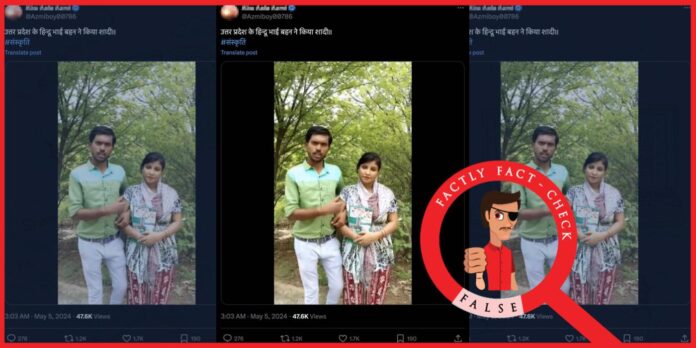Scripted video of Hindu brother-sister marriage has gone viral on social media, misleading viewers into believing that a brother and sister had married each other and were expecting a child. This controversial video has sparked outrage and shock, but fact-checkers have revealed that it is a staged production by content creator Kanhaiya Singh. The video even includes a disclaimer stating it is not a real incident, but it has been widely shared without context, fueling misinformation and debates online.
How The Scripted Video Went Viral?
The video in question portrays a shocking scenario where a woman appears to confess her marriage to her brother and announces her pregnancy. The staged nature of the video was overshadowed as snippets circulated on various platforms like Twitter, Facebook, and Instagram, misleading audiences. Many users expressed outrage, condemning the act and questioning moral and cultural values.
The controversy escalated when the video was shared as a genuine incident, with no acknowledgment of the disclaimer included by its creator. This highlights how easily misinformation can spread when content is taken out of context and shared without verification.
Fact-Checking The Scripted Video
Fact-checking organizations such as BOOM stepped in to clarify the origins and intent of the scripted video of Hindu brother-sister marriage. They found that the video was created by Kanhaiya Singh, a content creator known for producing dramatic and often controversial staged scenarios. Importantly, the video itself includes a disclaimer explicitly stating that it is fictional and not based on real events.
Despite this clarification, the video’s widespread dissemination as a real incident reflects the challenges of combating misinformation in the digital age. Even when disclaimers are present, the sensational nature of such content often overshadows the truth.
The Role Of Social Media In Misinformation
Social media platforms play a significant role in the rapid spread of fake news and misinformation. Viral content, like the scripted video of Hindu brother-sister marriage, gains traction because it evokes strong emotional reactions, such as shock or anger. Algorithms designed to prioritize engagement inadvertently amplify such content, making it harder for accurate information to reach audiences.
Platforms have implemented measures such as fact-checking labels and warnings for misleading content, but these measures are not foolproof. In this case, the disclaimer in the video was largely ignored or overlooked as it circulated on social media, underscoring the limitations of current safeguards.
Content Creation Vs. Responsible Messaging
The incident raises questions about the ethics of content creation. While creators like Kanhaiya Singh may produce staged videos for entertainment or awareness purposes, the potential for misinterpretation is high. Without clear disclaimers prominently displayed or context provided in every shared instance, such content can easily be taken at face value.
Creators must strike a balance between engaging audiences and being responsible for the potential impact of their work. Similarly, platforms and users must critically evaluate content before sharing or reacting to it, particularly when it involves sensitive topics.
Historical Instances Of Viral Misinformation
The scripted video of Hindu brother-sister marriage is not the first instance of misinformation gaining traction online. Similar incidents in the past have shown how quickly fabricated or misrepresented content can influence public opinion. For example:
- The “Fake Miracle Videos” Trend: Videos of supposedly miraculous events often turn out to be staged but are widely shared as authentic, fueling religious or cultural debates.
- The 2020 Migrant Worker Video: A staged video showing migrant workers’ plight during the COVID-19 lockdown went viral, misleading viewers and creating unnecessary panic.
These examples highlight the recurring nature of viral misinformation and the importance of media literacy in today’s digital landscape.
Public Reaction And Backlash
The public reaction to the scripted video of Hindu brother-sister marriage has been intense. Many users condemned the supposed act without verifying its authenticity, while others criticized the creator for producing such sensitive content in the first place. The backlash reveals a deeper issue of trust and skepticism in online spaces.
At the same time, the incident has sparked conversations about the need for critical thinking and fact-checking before reacting to sensational content. Public figures and influencers have also weighed in, urging users to verify information before amplifying it on social media.
The Importance Of Fact-Checking And Media Literacy
Incidents like this underline the critical role of fact-checking organizations and the need for media literacy among social media users. Fact-checkers serve as an essential line of defense against misinformation, but their reach is often limited compared to the virality of false content.
Media literacy initiatives can empower users to identify misleading content and verify its authenticity. Simple steps, such as checking the source, reading disclaimers, and cross-referencing information, can significantly reduce the spread of misinformation.
What Can Be Done To Prevent Misinformation?
The scripted video of Hindu brother-sister marriage offers several lessons for combating misinformation:
- Prominent Disclaimers: Content creators should ensure that disclaimers are clear, visible, and included in every instance where their videos are shared.
- Platform Accountability: Social media platforms must improve their algorithms to detect and limit the spread of potentially misleading content, especially when it involves sensitive topics.
- Education Campaigns: Governments, organizations, and platforms should invest in media literacy campaigns to help users identify and combat fake news.
- Fact-Checking Partnerships: Collaborations between platforms and fact-checking organizations can ensure quicker detection and correction of viral misinformation.
The Way Forward
As the dust settles on the controversy surrounding the scripted video of Hindu brother-sister marriage, it serves as a reminder of the double-edged nature of social media. While these platforms provide immense opportunities for communication and connection, they also amplify the risks of misinformation and sensationalism.
Users, creators, and platforms must work together to create a more informed and responsible digital environment. By promoting fact-checking, fostering critical thinking, and holding content creators accountable, society can mitigate the impact of such incidents and focus on building trust in the digital space.


